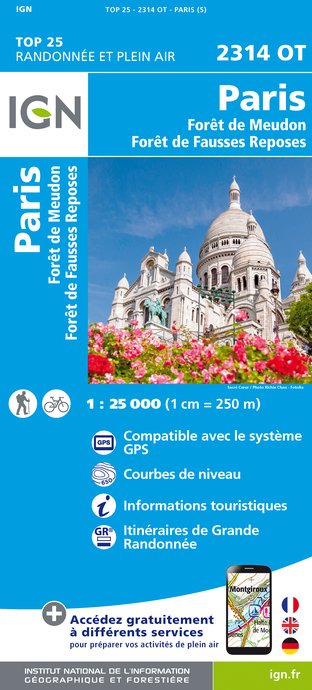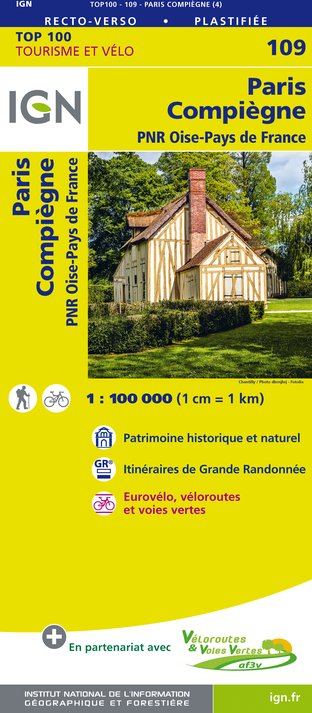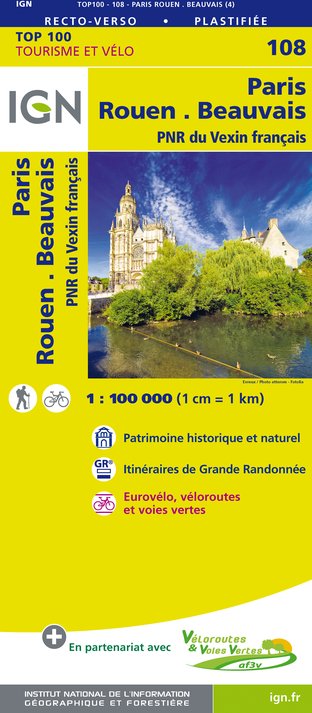Allarme
Allarmi
Tipo di pratica
A piedi
Molto facile
2h
In bicicletta
Molto facile
1h
Presentazione
Mappa
Punti di interesse
Sintesi di Cirkwi
Valutazioni e recensioni
Vedi nei dintorni
Freschezza e ritorno alle origini: le fontane di Parigi

Credito : Moonik via Wikipedia
Il breve di Cirkwi
Scopri Parigi: Un Viaggio Attraverso le Sue Iconiche Fontane
Proposto da Balades-Fluviales-An-Eala, questo viaggio è meno incentrato sulla meta e più sul viaggio stesso: una passeggiata attraverso la storia, guidata dalle affascinanti acque di Parigi. Immagina di farti strada attraverso le strade di Parigi, ogni svolta che si svela racconti di epoche passate, con il dolce rumore dell'acqua che ti fa compagnia. Lo scopo non è solo quello di mostrare il fascino estetico e storico di ogni fontana, ma di immergerti nell'atmosfera che creano: un'oasi di calma e bellezza nel cuore della città. Lascia che queste acque sussurrino le loro storie, dalle meraviglie monumentali alle gemme nascoste, arricchendo la tua passeggiata con strati di storia e cultura parigina.
Informazioni Tecniche sull'Itinerario
Questo itinerario, che copre una distanza di 6,8 km, si presenta come una passeggiata moderatamente facile, adatta agli appassionati di tutti i livelli di forma fisica. Partendo da un'altitudine di 27 metri e raggiungendo un picco di 41 metri, il percorso promette un minimo guadagno di altitudine di soli 23 metri in entrambe le direzioni, garantendo un ritmo rilassato durante tutto il percorso. Con queste specifiche, i viaggiatori possono godersi le viste panoramiche e le informazioni storiche senza ostacoli fisici. Di conseguenza, questa facilità tecnica migliora l'accessibilità del tour, invitando un gruppo diversificato di visitatori a partecipare.
Consigli Stagionali per gli Appassionati di Fontane
Intraprendere questo tour delle fontane a Parigi può essere una gioia durante tutto l'anno, ma ogni stagione offre esperienze uniche. In primavera, ammira la flora circostante in fiore, che offre uno sfondo vibrante alle acque storiche. L'estate, sebbene più calda, anima le fontane come oasi rinfrescanti; tuttavia, non dimenticare la crema solare e l'acqua! L'autunno offre un'elegante tonalità dorata, perfetta per gli appassionati di fotografia, mentre l'inverno, nonostante il freddo, offre un viaggio più tranquillo con meno affluenza. Indipendentemente dalla stagione, è consigliabile indossare calzature comode e essere sempre pronti a improvvisi cambiamenti nel clima parigino.
Parigi: Un Tessuto Storico Svelato
Parigi, situata nella regione dell'Île-de-France, non è solo la capitale del paese, ma anche il suo cuore storico e culturale. L'insieme di fontane della città è emblematico della sua storia stratificata, ognuna che racconta storie di cambiamenti sociali, movimenti architettonici e sviluppo urbano. Dai tempi delle ristrutturazioni di Haussmann, che hanno trasformato radicalmente Parigi per combattere le crisi sanitarie pubbliche, alla preservazione di questi tesori acquatici oggi, il percorso di queste fontane riflette l'evoluzione dinamica di Parigi stessa. Rimangono come narratori silenziosi del passato, testimoni del costante cammino della città nel tempo.
Guida al Clima per i Visitatori di Parigi
Parigi, con il suo clima temperato oceanico, gode di temperature miti durante tutto l'anno. Le primavere e gli autunni sono particolarmente piacevoli, rendendoli i momenti ideali per esplorare le meraviglie all'aperto come le sue fontane storiche. I inverni sono relativamente miti ma possono avere periodi più freddi, mentre le estati, sebbene più calde, mantengono generalmente temperature confortevoli: un vantaggio per coloro che cercano sollievo nelle fresche acque. Per massimizzare la tua esperienza, considera di visitare da aprile a giugno o da settembre a novembre, quando il clima è più favorevole per girovagare e scoprire il patrimonio all'aperto di Parigi.
Proposto da Balades-Fluviales-An-Eala, questo viaggio è meno incentrato sulla meta e più sul viaggio stesso: una passeggiata attraverso la storia, guidata dalle affascinanti acque di Parigi. Immagina di farti strada attraverso le strade di Parigi, ogni svolta che si svela racconti di epoche passate, con il dolce rumore dell'acqua che ti fa compagnia. Lo scopo non è solo quello di mostrare il fascino estetico e storico di ogni fontana, ma di immergerti nell'atmosfera che creano: un'oasi di calma e bellezza nel cuore della città. Lascia che queste acque sussurrino le loro storie, dalle meraviglie monumentali alle gemme nascoste, arricchendo la tua passeggiata con strati di storia e cultura parigina.
Informazioni Tecniche sull'Itinerario
Questo itinerario, che copre una distanza di 6,8 km, si presenta come una passeggiata moderatamente facile, adatta agli appassionati di tutti i livelli di forma fisica. Partendo da un'altitudine di 27 metri e raggiungendo un picco di 41 metri, il percorso promette un minimo guadagno di altitudine di soli 23 metri in entrambe le direzioni, garantendo un ritmo rilassato durante tutto il percorso. Con queste specifiche, i viaggiatori possono godersi le viste panoramiche e le informazioni storiche senza ostacoli fisici. Di conseguenza, questa facilità tecnica migliora l'accessibilità del tour, invitando un gruppo diversificato di visitatori a partecipare.
Consigli Stagionali per gli Appassionati di Fontane
Intraprendere questo tour delle fontane a Parigi può essere una gioia durante tutto l'anno, ma ogni stagione offre esperienze uniche. In primavera, ammira la flora circostante in fiore, che offre uno sfondo vibrante alle acque storiche. L'estate, sebbene più calda, anima le fontane come oasi rinfrescanti; tuttavia, non dimenticare la crema solare e l'acqua! L'autunno offre un'elegante tonalità dorata, perfetta per gli appassionati di fotografia, mentre l'inverno, nonostante il freddo, offre un viaggio più tranquillo con meno affluenza. Indipendentemente dalla stagione, è consigliabile indossare calzature comode e essere sempre pronti a improvvisi cambiamenti nel clima parigino.
Parigi: Un Tessuto Storico Svelato
Parigi, situata nella regione dell'Île-de-France, non è solo la capitale del paese, ma anche il suo cuore storico e culturale. L'insieme di fontane della città è emblematico della sua storia stratificata, ognuna che racconta storie di cambiamenti sociali, movimenti architettonici e sviluppo urbano. Dai tempi delle ristrutturazioni di Haussmann, che hanno trasformato radicalmente Parigi per combattere le crisi sanitarie pubbliche, alla preservazione di questi tesori acquatici oggi, il percorso di queste fontane riflette l'evoluzione dinamica di Parigi stessa. Rimangono come narratori silenziosi del passato, testimoni del costante cammino della città nel tempo.
Guida al Clima per i Visitatori di Parigi
Parigi, con il suo clima temperato oceanico, gode di temperature miti durante tutto l'anno. Le primavere e gli autunni sono particolarmente piacevoli, rendendoli i momenti ideali per esplorare le meraviglie all'aperto come le sue fontane storiche. I inverni sono relativamente miti ma possono avere periodi più freddi, mentre le estati, sebbene più calde, mantengono generalmente temperature confortevoli: un vantaggio per coloro che cercano sollievo nelle fresche acque. Per massimizzare la tua esperienza, considera di visitare da aprile a giugno o da settembre a novembre, quando il clima è più favorevole per girovagare e scoprire il patrimonio all'aperto di Parigi.
Generato automaticamente.
IGN Carte

2314OT - PARIS FORÊT DE MEUDON FORÊT DE FAUSSES REPOSES
Editore : IGN
Collezione : TOP 25 ET SÉRIE BLEUE
Scala : 1:25 000
13.90€

119 PARIS SENS PNR DU GÂTINAIS FRANÇAIS
Editore : IGN
Collezione : TOP 100
Scala : 1:100 000
8.40€

190 PARIS CHANTILLY FONTAINEBLEAU
Editore : IGN
Collezione : TOP 100
Scala : 1:100 000
8.40€

118 PARIS CHARTRES PNR DE LA HAUTE VALLÉE DE CHEVREUSE
Editore : IGN
Collezione : TOP 100
Scala : 1:100 000
8.40€

109 PARIS COMPIÈGNE PNR OISE-PAYS DE FRANCE
Editore : IGN
Collezione : TOP 100
Scala : 1:100 000
8.40€

108 PARIS ROUEN BEAUVAIS PNR DU VEXIN FRANÇAIS
Editore : IGN
Collezione : TOP 100
Scala : 1:100 000
8.40€

D75-95 ÎLE-DE-FRANCE OUEST
Editore : IGN
Collezione : CARTES DÉPARTEMENTALES IGN
Scala : 1:150 000
5.90€

D77 SEINE-ET-MARNE
Editore : IGN
Collezione : CARTES DÉPARTEMENTALES IGN
Scala : 1:150 000
5.90€

NR08 CENTRE-VAL DE LOIRE
Editore : IGN
Collezione : CARTES RÉGIONALES IGN
Scala : 1:250 000
6.80€

NR03 ÍLE DE FRANCE
Editore : IGN
Collezione : CARTES RÉGIONALES IGN
Scala : 1:250 000
6.80€

NR01 HAUTS-DE-FRANCE
Editore : IGN
Collezione : CARTES RÉGIONALES IGN
Scala : 1:250 000
6.80€

801 FRANCE NORD OUEST
Editore : IGN
Collezione : CARTES NATIONALES IGN
Scala : 1:320 000
6.10€

EUROPE
Editore : IGN
Collezione : DÉCOUVERTE DES PAYS DU MONDE IGN
Scala : 1:2 500 000
7.00€
Informazioni tecniche
A piedi
Difficoltà
Molto facile
Durata
2h
(1g)
Dist.
6.8 km
Tipo di pratica
A piedi
Molto facile
2h
In bicicletta
Molto facile
1h
Mostra di più
Profilo altimetrico
Punto di partenza
75006
Paris
Lat : 48.8534421Lng : 2.3437786
Punti di interesse
Autore dei dati

proposto da
Balades-Fluviales-An-Eala
Valutazioni e recensioni
Da vedere nei dintorni







